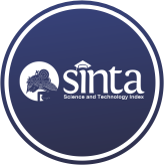Klasifikasi Gempa Bumi Berdasarkan Magnitudo Menggunakan Metode Logistic Regression
(1) Universitas Semarang, Indonesia
(2) Universitas Semarang, Indonesia
(3) Universitas Semarang, Indonesia
(*) Corresponding Author
Abstract
Full Text:
PDFReferences
R. Maharani, A. Hutagaol, V. T. Lana, Z. Azzahra, and R. Kurniawan, “Penerapan Machine Learning dalam Prediksi Klasifikasi Big Data Kedalaman Gempa Bumi di Indonesia Tahun 2015-2024,” vol. 2024, no. Senada, pp. 42–51, 2024.
F. Pikriyati, “Perbandingan Algoritma Regresi Linear Dan Polynomial Pada Prediksi Kasus Gempa Bumi Di Indonesia,” vol. V, pp. 87–93, 2024.
D. Christianto, N. Tarmidzi, and S. Atmaja, “Manajemen Penyebaran Informasi Gempabumi di Media Televisi oleh Badan Meteorologi, Klimatologi dan Geofisika,” Buana Komun. (Jurnal Penelit. dan Stud. Ilmu Komunikasi), vol. 4, no. 2, p. 138, 2023, doi: 10.32897/buanakomunikasi.2023.4.2.2786.
A. Tania, T. Handhayani, and J. Hendryli, “Perbandingan Antara Algoritma K-Means Dan Algoritma Bisecting K-Means Dalam Menganalisis Gempa Bumi Di Indonesia,” Simtek J. Sist. Inf. dan Tek. Komput., vol. 8, no. 2, pp. 265–270, 2023, doi: 10.51876/simtek.v8i2.205.
I. Irawan, Y. Subiakto, and B. Kustiawan, “Manajemen Mitigasi Bencana Pada Pendidikan Anak Usia Dini untuk Mengurangi Risiko Bencana Gempa Bumi,” PENDIPA J. Sci. Educ., vol. 6, no. 2, pp. 609–615, 2022, doi: 10.33369/pendipa.6.2.609-615.
N. S. Bengi, S. Syamsul, and N. Nasri, “Prototype Sistem Pendeteksi Gempa Bumi Dan Peringatan Dini Berbasis Internet of Things,” J. TEKTRO, vol. 8, no. 1, pp. 138–144, 2024.
R. Wahyu Pratama, Y. Herry Chrisnanto, and G. Gunawan, “Klasifikasi Efek Kerusakan Gempa Bumi Berdasarkan Skala Modified Mercalli Intensity Menggunakan Algoritma Multiclass Support Vector Machine,” JATI (Jurnal Mhs. Tek. Inform., vol. 8, no. 2, pp. 1739–1745, 2024, doi: 10.36040/jati.v8i2.9211.
R. S. Tantika and A. Kudus, “Penggunaan Metode Support Vector Machine Klasifikasi Multiclass pada Data Pasien Penyakit Tiroid,” Bandung Conf. Ser. Stat., vol. 2, no. 2, pp. 159–166, 2022, doi: 10.29313/bcss.v2i2.3590.
A. Prasetio, M. M. Effendi, and M. N. Dwi M, “Analisis Gempa Bumi Di Indonesia Dengan Metode Clustering,” Bull. Inf. Technol., vol. 4, no. 3, pp. 338–343, 2023, doi: 10.47065/bit.v4i3.820.
J. S. Hutagalung and Rasiban, “Analisis Sentimen Keuangan (Data Fiqa and Financial Phrasebank) Menggunakan Algoritma Logistic Regression Dan Support Vector Machine,” J. Indones. Manaj. Inform. dan Komun., vol. 4, no. 3, pp. 1654–1669, 2023, doi: 10.35870/jimik.v4i3.404.
I. A. Ricky, I. F. Hanif, F. N. Hasan, E. S. Sinduningrum, Z. Halim, and N. Nunik, “Analisis Sentimen Opini Masyarakat Terkait Penyelenggaraan Sistem Elektronik Menggunakan Metode Logistic Regression,” J. Linguist. Komputasional, vol. 5, no. 2, p. 77, 2022, [Online]. Available: https://t.co/23c4krbjp
Greessheilla Phylosta P.B and Rido Febryansyah, “Permohonan Pinjaman Pada Koperasi Simpan Pinjam,” Ilmudata.org, vol. 2, no. 12, pp. 1–12, 2022.
A. R. C. Adi, “Analisis Kepuasan Pelayanan Rumah Sakir Mitra Husada Pringsewi Menggunakaan Metode Logistic Regression,” J. Ilmu Data, vol. 2, no. 12, pp. 1–11, 2022, [Online]. Available: http://ilmudata.org/index.php/ilmudata/article/view/290%0Ahttp://ilmudata.org/index.php/ilmudata/article/download/290/276
M. Fahmuddin, M. K. Aidid, and M. J. Taslim, “Implementasi Analisis Regresi Logistik Dengan Metode Machine Learning Untuk Mengklasifikasi Berita Di Indonesia,” VARIANSI J. Stat. Its Appl. Teach. Res., vol. 5, no. 03, pp. 155–162, 2023, doi: 10.35580/variansiunm116.
H. M. Ibrahim, H. Skovorodnikov, and H. Alkhzaimi, “Resilience evaluation of memristor based PUF against machine learning attacks,” Sci. Rep., vol. 14, no. 1, p. 23962, 2024, doi: 10.1038/s41598-024-73839-1.
D. N. Ardelia, H. D. Arifin, S. Daniswara, and A. P. Sari, “Klasifikasi Harga Ponsel Menggunakan Algoritma Logistic Regression,” vol. 04, no. 01, pp. 37–43, 2024.
DOI: https://doi.org/10.30645/kesatria.v6i1.564
DOI (PDF): https://doi.org/10.30645/kesatria.v6i1.564.g559
Refbacks
- There are currently no refbacks.
Published Papers Indexed/Abstracted By:














